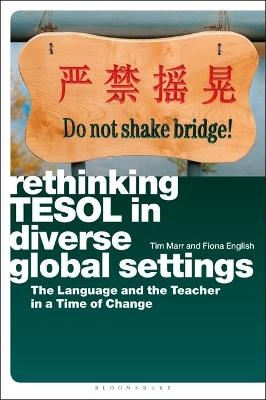
Rethinking TESOL in Diverse Global Settings
Bloomsbury Academic (Verlag)
978-1-350-03345-0 (ISBN)
What do TESOL teachers actually teach? What do they know about language, about English and the ways it is used in the world? How do they view themselves and their work, and how are they viewed by others? How is TESOL perceived as a profession and as a discipline? How can teachers make the most of the available resources? Can global English really deliver what it seems to promise? These are some of the questions explored in Rethinking TESOL in Diverse Global Settings, a book which examines what we mean when we talk about English language teaching and what we understand the job of an English language teacher to be.
Covering diverse teaching environments, from China to Latin America and the Middle East, and from elementary school to university, the authors take a critical look at TESOL by focusing on the actual substance of the subject, language, and attitudes towards it. Through concrete examples from language classrooms, in the form of vignettes and accounts from native speaker and non-native speaker teachers alike, they explore the experiences of teachers worldwide in relation to issues of identity and professionalism, nativeness and non-nativeness, and the pressures of dealing with the expectations with which English has become invested. While recognising the often precarious academic and institutional status of TESOL teachers, the book pulls no punches in challenging those teachers as a whole to become more ambitious in their aims, positioning themselves not as mere skills providers, but language experts, specialists in their subject, members of a legitimate academic discipline. Only then, the authors argue, will TESOL teachers and their work be taken seriously and their expertise recognised.
Tim Marr is Visiting Professor in TESOL and Applied Linguistics at Universidad Icesi, Colombia. Fiona English is Honorary Senior Research Associate at the Centre for Applied Linguistics at IOE, UCL’s Faculty of Education and Society, University College London, UK. She is the author of Student Writing and Genre (Bloomsbury, 2011) Together they are the authors of Why Do Linguistics (Bloomsbury, 2015)
1. Introduction: What Is It about Language Teachers and Language?
2. Is English Different? The Numbers and the Narratives
3. What Kind of Language Do We Teach? Lingua Francas and Lingua Franca English
4. What Do Learners Expect to Learn? Beliefs, Prospects and Realities
5. What Does It Mean To Be an English Language Teacher? Identity and Expertise
6. How Does Linguistics Help? (1) – Describing Language
7. How Does Linguistics Help? (2) – Analysing Language
8. What Does the Learner Bring to the Classroom? Students’ Linguistic and Cultural Capital
9. What Makes a Classroom Authentic? English Inside and Outside the Classroom
10. Conclusion: What Do I Teach when I Teach English?
References
Index
| Erscheinungsdatum | 08.02.2019 |
|---|---|
| Verlagsort | London |
| Sprache | englisch |
| Maße | 156 x 234 mm |
| Gewicht | 408 g |
| Themenwelt | Schulbuch / Wörterbuch ► Wörterbuch / Fremdsprachen |
| Geisteswissenschaften ► Sprach- / Literaturwissenschaft ► Sprachwissenschaft | |
| Sozialwissenschaften ► Pädagogik ► Schulpädagogik / Grundschule | |
| ISBN-10 | 1-350-03345-6 / 1350033456 |
| ISBN-13 | 978-1-350-03345-0 / 9781350033450 |
| Zustand | Neuware |
| Haben Sie eine Frage zum Produkt? |
aus dem Bereich


